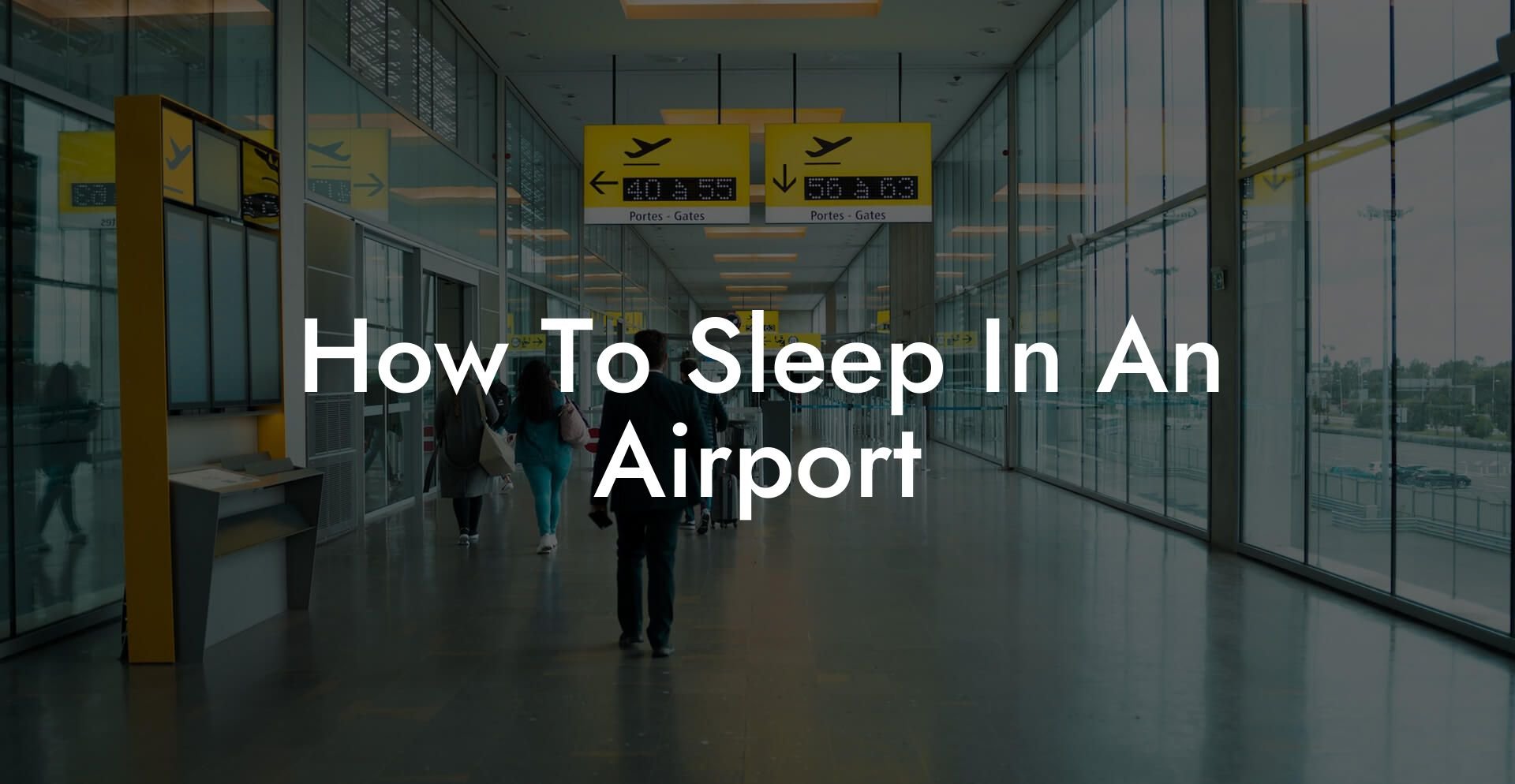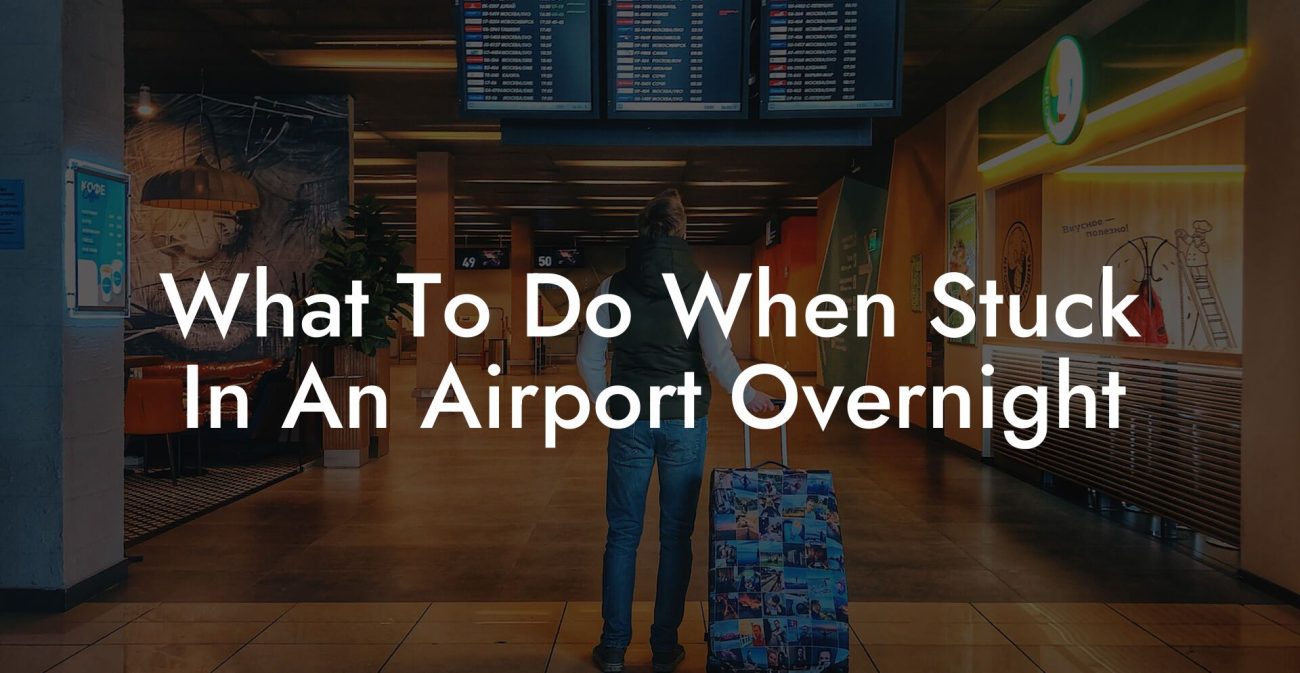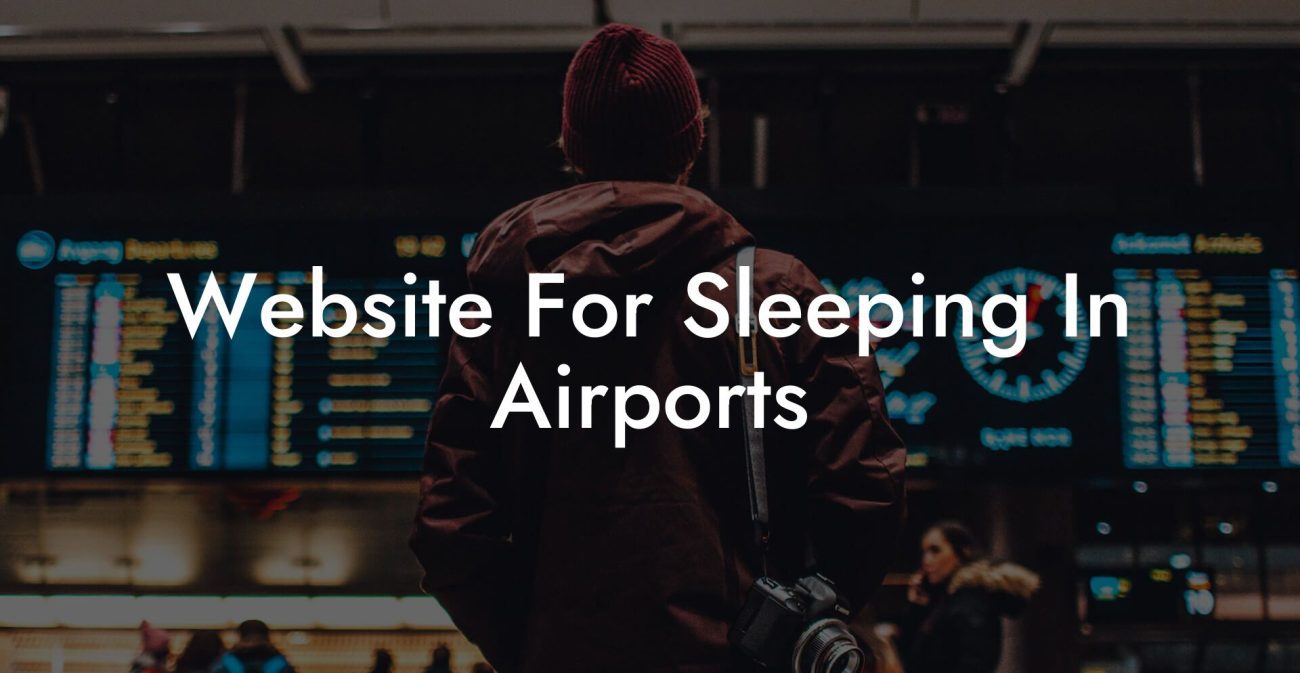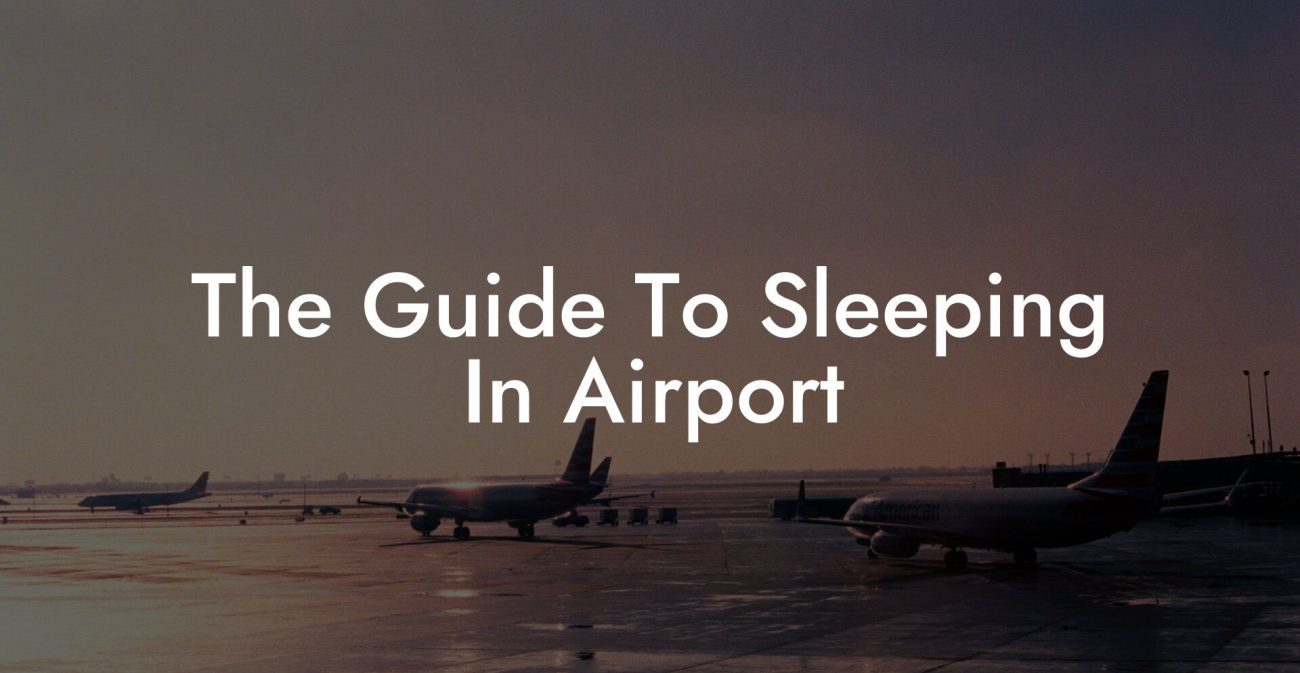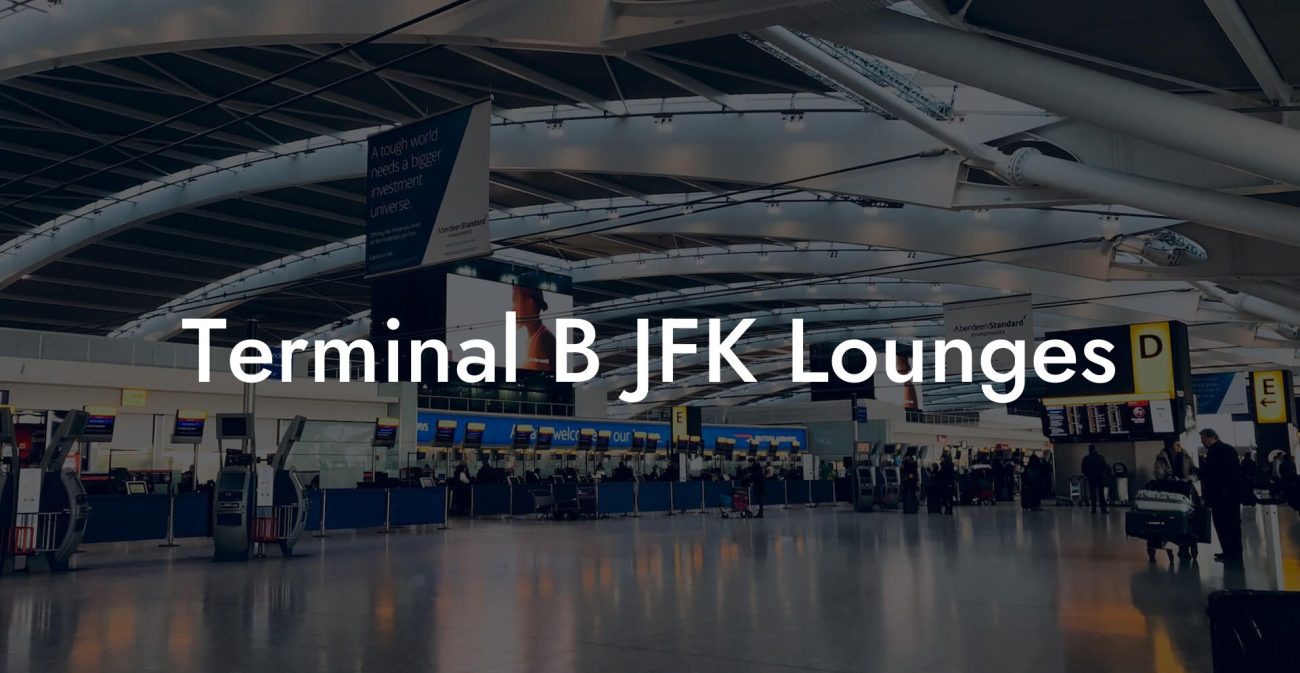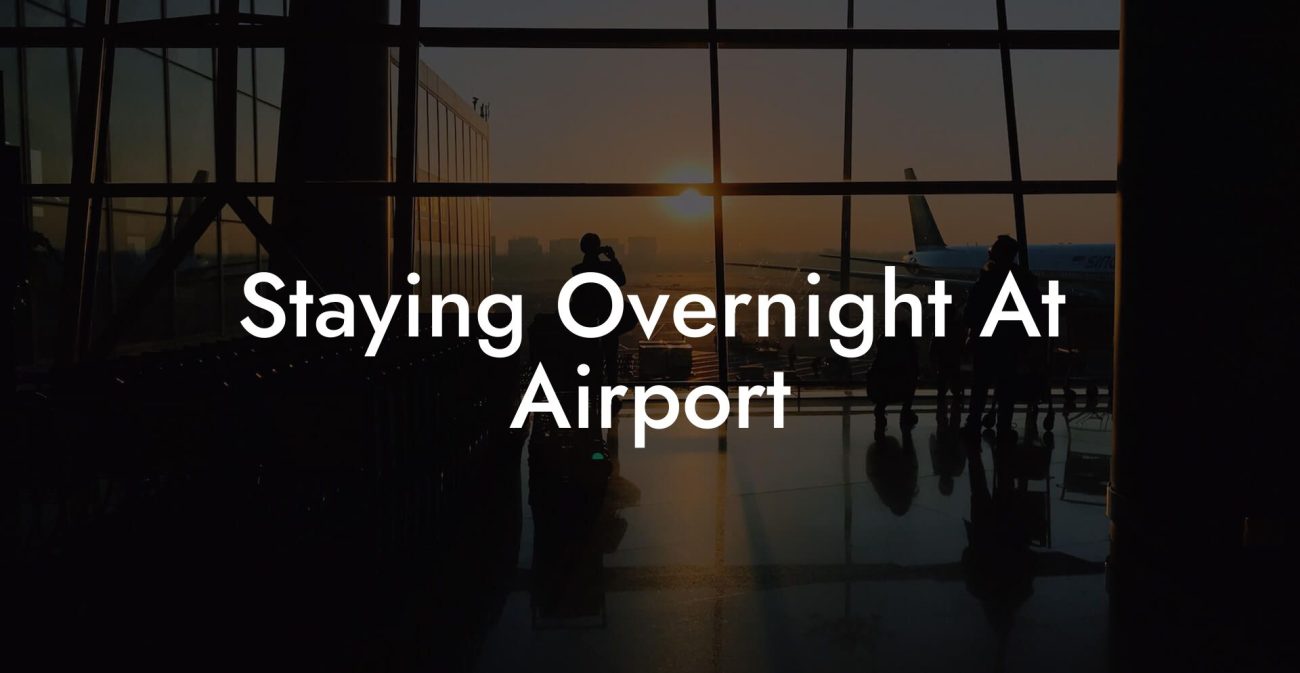Tired of tossing and turning in cramped airplane seats? Ready to transform your next layover into a snooze-fest worth bragging about? Whether you’re a Gen-Z globetrotter or a millennial on a mission, sleeping in an airport can be a wild ride of adventure, resourcefulness, and yes, surprisingly cozy naps. Buckle up (or better yet, unzip that hoodie) as we dive into the ultimate guide on how to sleep in an airport—complete with pro tips, insider hacks, and a few laughs along the way.
Quick Links to Useful Sections
- How to Master the Art of Airport Sleep
- Understanding the Airport Sleep Environment
- Pre-Flight Prep: Setting the Stage for Airport Slumber
- Scout the Best Spots: Where to Sleep in an Airport
- 1. Dedicated Rest Zones and Sleep Pods
- 2. Lounge Access and Public Seating
- 3. Hidden Nooks and Quiet Corridors
- 4. Family Rooms and Unoccupied Conference Areas
- Airport Sleeping Pods: The Future of Terminal Napping
- Airport Sleep Hacks: Gear, Technology, and Must-Have Apps
- Sleep Gear Essentials
- Tech Tools to Enhance Your Zzz’s
- Clever Hacks to Create Your Ideal Sleep Environment
- Prepping for the Unexpected: What to Do If You Can’t Sleep
- Embrace Alternative Relaxation Techniques
- Stay Engaged: Light Activities to Wind Down
- Plan for a Post-Attempt Reboot
- Safety and Security When Sleeping in an Airport
- Time Management: Balancing Sleep and Exploring the Terminal
- Fueling Your Body: Healthy Habits to Adopt Before Sleeping in an Airport
- Real Stories: Tales from the Terminal
- The Midnight Layover Miracle
- A Family’s Unexpected Retreat
- Solo Adventures and Digital Detoxes
- Creating Your Personalized Airport Sleep Routine
- Step 1: Assess Your Sleep Needs
- Step 2: Research Your Airport’s Amenities
- Step 3: Pack Your Sleep Essentials
- Step 4: Set a Flexible Schedule
- Step 5: Follow Up with Self-Care
- Resources and Community Support: Your Next Steps
- Frequently Asked Questions About Airport Sleep
- Your Next Steps to Becoming an Airport Sleep Pro
How to Master the Art of Airport Sleep
Let’s face it: airports aren’t exactly known for their plush bedding or serene nap nooks, but with a little creativity and some savvy planning, that hard bench can become your ticket to dreamland. In this guide, we’re turning your terminal into the most unexpected sleep sanctuary. From scouting out the comfiest corners to leveraging the latest airport sleeping pods, we have every detail covered so you can catch those Zzz’s without missing your flight.
Airport sleeping isn’t just about hunkering down for a power nap—it’s an art form that blends ingenuity with a bit of insider know-how. Whether you’re braving a long layover or purposely booking a red-eye, our tips will guide you through everything from choosing the right gear to navigating security protocols while you drift off.
Ready to turn a hectic terminal into a restful retreat? Let’s break down the essentials and show you why sleeping in an airport is not only doable, but can also become a surprisingly enjoyable part of your travel routine.
Understanding the Airport Sleep Environment
Airports are peculiar spaces—designed for transit, not tranquility. Yet, if you know where and how to look, you can uncover hidden havens within these sprawling travel hubs. From quiet corners in lesser-known terminals to designated rest zones—and yes, even the now-ubiquitous airport sleeping pods—these locations can serve as your personal sleep oasis.
The first step to a successful airport nap is understanding the lay of the land. Most modern airports have dedicated “sleep zones” that cater to weary travelers. These areas often come equipped with reclining chairs, dim lighting, and sometimes even charging stations. But what if your airport doesn’t have a nap-friendly lounge? Fear not—our guide also includes a treasure trove of tips for transforming less-than-ideal spots into sleep-inducing environments.
Look out for quiet corners away from the hustle and bustle, or even those secluded spots behind immaculately trimmed potted plants. Every airport has its hidden gems; you just have to know how to find them.
Pre-Flight Prep: Setting the Stage for Airport Slumber
Preparation is everything when it comes to catching quality sleep in a public space. Reclaim your downtime by equipping yourself with a travel pillow that mimics your favorite couch, a lightweight blanket for warmth, and noise-canceling headphones to drown out the endless announcements. Packing smart means you’re always ready for an impromptu nap.
Don’t forget the little extras: an eye mask can block out harsh terminal lighting, and a couple of earplugs or a white noise app can be lifesavers when facing overlapping conversations and rolling suitcases. Gen-Z travelers often swear by travel apps that map out quiet spots using community reviews—this can be a game changer when you’re trying to track down that elusive cozy corner.
Once you’ve got your sleep kit in tow, it’s all about timing. Time your snooze for when the terminal is at its quietest—usually during off-peak hours or in terminals experiencing a lull. Studying the flight schedules can provide insights into the natural ebb and flow of crowds, so you can plan the perfect time to catch some shut-eye.
Scout the Best Spots: Where to Sleep in an Airport
Not all spots in an airport are created equal when it comes to sleep quality. We’re talking about strategic snooze zones that blend the right blend of comfort, safety, and minimal disturbance. Here are several options to consider:
1. Dedicated Rest Zones and Sleep Pods
As airports embrace the needs of weary travelers, rest zones and sleeping pods have become a common sight. These self-contained sleeping units are designed to offer privacy, ambient lighting, and comfy seating that transforms into a semi-bed. Check your airport’s website or mobile app—if they have sleeping pods available, booking one pre-flight could secure you that uninterrupted rest.
2. Lounge Access and Public Seating
If you’re lucky enough to access an airline lounge, you’re already one step ahead of the game. Lounges often offer reclining chairs, even mini-bed setups, and a generally soothing ambiance designed for relaxation. However, if you’re sticking to public seating areas, look for chairs that recline, offer arm support, and aren’t too close to high-traffic areas.
3. Hidden Nooks and Quiet Corridors
Sometimes the best sleeping spots are off the beaten path—a rarely frequented corridor, an unused gate area, or the back of a long hallway. Urban explorers and seasoned travelers have uncovered some of these spots by observing the ebb and flow of airport traffic. Try to position yourself near a wall or a sturdy fixture so you can anchor your belongings and feel secure.
4. Family Rooms and Unoccupied Conference Areas
Many airports offer family rooms or unoccupied business centers that double as power nap havens. These spaces are often quieter and less frequented than the main seating areas. In some airports, you might even find designated “nap rooms” that are underutilized during off-peak times.
With multiple locations to choose from, the key is to remain flexible. Scout out different areas upon arrival, and always have a backup plan in case your ideal spot suddenly becomes the new hotspot for fellow snooze-seekers.
Airport Sleeping Pods: The Future of Terminal Napping
Ever dreamed of a mini-version of an Airbnb right in the middle of an airport terminal? Enter the airport sleeping pods—a revolutionary solution that’s shaking up the traditional airport lounge scene. These futuristic pods are designed with the modern traveler in mind: sleek, private, and technologically savvy.
Typically outfitted with adjustable lighting, climate control, power outlets, and sometimes even Wi-Fi, sleeping pods can be a luxurious alternative to the standard terminal seat. They’re perfect for recovering from jet lag, catching up on work, or simply recharging your energy before the next leg of your journey.
The best part? Many airports around the globe are now offering these high-tech havens for a reasonable fee. By booking in advance or using an airport app to snag a last-minute deal, you can elevate your travel experience from “meh” to memorable.
If you’re curious about their practicality, think of sleeping pods as the cocoon you need to emerge as a refreshed, well-rested version of yourself, ready to conquer the city you’re about to explore.
Airport Sleep Hacks: Gear, Technology, and Must-Have Apps
For the tech-savvy traveler, a little innovation can go a long way in transforming your airport sleep experience. Let’s dive into the gadgets and apps that can make or break your nap in the terminal:
Sleep Gear Essentials
Invest in a high-quality travel pillow—one that supports your neck without sucking the life out of your posture. A compact travel blanket not only keeps you warm but also adds a layer of privacy. Consider a pair of noise-canceling headphones; they’re worth every cent when it comes to blocking out the ambient hum of airport life.
Tech Tools to Enhance Your Zzz’s
Several apps are designed specifically to help travelers get restful sleep while on the go. White noise apps, sleep timers, and alarm clocks that feature gentle wake-up sounds can turn even the busiest terminal into your personal sleep lab. Some airports even have NFC-enabled kiosks that provide real-time information about available sleeping spots and pod availability.
Clever Hacks to Create Your Ideal Sleep Environment
If you find yourself in a less-than-ideal spot, improvise! Drape a light scarf or shawl over your head to create a makeshift eye mask, or use your carry-on as a pillow. Pro tip: a water bottle can double as a door stopper to prevent unwanted chair rotations.
The crux of airport sleeping is creativity. No matter how state-of-the-art your gear might be, sometimes all it takes is a little ingenuity to carve out the perfect nap nook in the chaos of modern travel.
Prepping for the Unexpected: What to Do If You Can’t Sleep
Not every airport scenario is picture-perfect for snoozing, and sometimes despite your best efforts, sleep might remain elusive. Instead of stressing about lost sleep or resorting to constant caffeine fixes, here are some strategies to make the most of your time:
Embrace Alternative Relaxation Techniques
When sleep evades you, focus on relaxation — think of it as “quiet time.” Engage in meditation or deep breathing exercises, which can help calm your mind and even set the stage for eventual sleep. A mindfulness app or a quick podcast episode might be just what you need to ease your anxiety while waiting for your flight.
Stay Engaged: Light Activities to Wind Down
If nodding off isn’t an option, consider light reading, sketching a travel journal, or even doing a gentle stretch routine in a quiet corner. These activities can help reduce the stress of a long wait and recharge your mental batteries, so you’re ready to sleep during the flight.
Plan for a Post-Attempt Reboot
Keep a backup plan ready for when sleep simply won’t come. Sometimes, indulging in a warm beverage or treating yourself to a meal at the airport’s food court can perk up your mood and make waiting much more bearable. Remember, every moment counts on a long journey, and using your time wisely—even if it’s not spent sleeping—can turn a layover into a productive experience.
Safety and Security When Sleeping in an Airport
Sleeping in a public space comes with its own set of challenges and concerns, especially when it involves security. The good news is that with a few practical precautions, you can rest easy (quite literally) without worrying about your belongings.
Always keep your passport, wallet, and valuable items on you, ideally snug in a secure travel pouch under your clothes or in an anti-theft backpack. Consider using a lock on your luggage, and position your belongings near you when you set up camp for the night. Familiarize yourself with the airport layout and identify emergency exits and security stations—the more you know, the safer you feel.
Trust your instincts. If a location feels unsafe, don’t hesitate to move to another area. Many airports have designated safe zones or family areas specifically for this reason. By staying alert and using common sense, you can enjoy a restful sleep without compromising your personal safety.
Time Management: Balancing Sleep and Exploring the Terminal
One of the trickier parts of airport sleeping is striking the perfect balance between sleep and exploration. After all, airports aren’t just pit stops—they’re bustling microcosms of modern travel. Use your layover time wisely: a short nap can be a perfect pick-me-up before you embark on an impromptu terminal walk or even a spot of duty-free shopping.
Schedule your sleep sessions based on your flight timings and check for any alerts or boarding calls that might disrupt your slumber. A well-timed power nap can be the secret weapon to surviving a marathon airport trek.
Fueling Your Body: Healthy Habits to Adopt Before Sleeping in an Airport
Let’s not forget the basics: quality sleep is inextricably linked to how you fuel your body. Packing light, healthy snacks and staying hydrated are keys to a refreshing slumber.
Instead of piling on the caffeine when you’re in desperate need of energy, opt for fresh fruits, nuts, or a protein bar that will sustain you through the long hours of waiting. Hydration, as simple as it sounds, helps in keeping you alert when necessary and aids in a more harmonious sleep cycle—especially if you’re trying to adapt to a different time zone.
Some airports have yoga or meditation spaces that double as wellness hubs. Taking a few minutes to stretch or perform a simple breathing exercise can prime your body for relaxation, ensuring that your nap—however brief—is as restorative as possible.
Real Stories: Tales from the Terminal
Nothing beats a real-life story to remind you that you’re not alone in this airport-sleeping saga. Countless travelers have turned what was once seen as a last-resort tactic into a celebrated art form. Here are a few humorous and heartwarming experiences shared by fellow globetrotters:
The Midnight Layover Miracle
Alex, a perpetual night owl, found himself stranded in a busy European airport after a delayed flight. Rather than succumbing to anxiety at his impending layover, he discovered a secluded corner behind a row of potted plants. With just a travel pillow and his favorite playlist, Alex managed to capture a miraculous 90 minutes of sleep that left him feeling surprisingly refreshed—and even earned him a few envious nods from fellow travelers.
A Family’s Unexpected Retreat
The Lim family, on a long road trip to visit relatives overseas, decided to make the most of a four-hour layover. They transformed an empty gate area into an impromptu lounge, complete with blankets, a shared snack, and synchronized power naps. What started as a stressful wait turned into an opportunity for bonding, creative storytelling, and plenty of laughs—reminding everyone that community and adaptability can turn any space into a home away from home.
Solo Adventures and Digital Detoxes
For many solo travelers, an airport nap is not just a chance to catch up on sleep but a chance to disconnect from the digital world. Jamie, a self-proclaimed social media detox advocate, used a long layover to completely unplug in an underused corridor. Freed from notifications, Jamie discovered the art of introspection and slow living—a mindful rest that left him inspired for the adventures ahead.
These stories serve as a reminder that even in the midst of chaos, you can carve out a moment of peace, recharge your batteries, and even find a few gems of human connection.
Creating Your Personalized Airport Sleep Routine
The secret sauce to nailing airport sleep lies in personalizing your approach. With a little creativity and some trial and error, you can develop a routine that caters specifically to your habits and preferences.
Step 1: Assess Your Sleep Needs
Evaluate how much sleep your body really needs to function at its best. Whether you’re aiming for a quick power nap or planning to get an entire sleep cycle in, having a clear goal in mind will help you structure your routine.
Step 2: Research Your Airport’s Amenities
Every airport has its personality. Spend a few minutes researching your terminal online or ask airport staff about available sleeping spots, lounges, or sleeping pods. Community reviews and travel forums are treasure troves of tips and can help you pinpoint the quietest areas.
Step 3: Pack Your Sleep Essentials
Create your own airport sleep kit—a compact bag filled with your must-have sleep gear (travel pillow, blanket, eye mask, earplugs, and maybe even your favorite soothing tea). Having everything at your fingertips means you’re always ready to transform a busy terminal into a restful retreat.
Step 4: Set a Flexible Schedule
Flexibility is key. While it’s great to have a planned sleep window, allow for adjustments based on real-time factors like gate changes, boarding calls, or unexpected terminal buzz. Adapt and go with the flow—the best sleep routines are the ones that can pivot when needed.
Step 5: Follow Up with Self-Care
After your airport nap, take a few minutes to rehydrate, stretch, and maybe even indulge in a snack. A little self-care post-nap can ensure that the sleep, however brief, leaves you feeling genuinely refreshed.
With these steps, you can design a personalized approach that turns airport sleep from an afterthought into an empowering travel ritual.
Resources and Community Support: Your Next Steps
The quest for the perfect airport nap is a shared journey, and you’re not alone. Countless travel blogs, online communities, and social media groups are dedicated to swapping tips, uncovering hidden gems, and supporting fellow travelers in their pursuit of restful layovers.
Connect with travel influencers who specialize in airport hacks, join forums where seasoned jet-setters reveal their secret sleeping spots, and follow airport-specific apps that offer real-time updates on lounge availability and quiet zones.
Not only will these resources expand your travel toolkit, but they can also introduce you to a community where every member is committed to turning travel chaos into moments of restful recharge. Share your own experiences, swap sleep stories, and contribute to a growing network that makes airport sleeping both sustainable and fun.
Ready for your next adventure? Brush up on these tips, pack your sleep kit like the pro you are, and jump into your next flight with newfound confidence and a ready-to-relax attitude. Your journey to transforming every layover into a sleep oasis is just beginning.
Frequently Asked Questions About Airport Sleep
We know you’ve got questions—here are some of the most frequently asked ones, answered by seasoned travelers who’ve made airport sleeping a true art form.
1. Is it really safe to sleep in an airport?
Absolutely, as long as you take basic precautions. Keep your valuables close, choose well-lit and populated areas, and trust your instincts. Most major airports offer designated rest zones that are monitored for security, ensuring you can rest with peace of mind.
2. What if I can’t find a comfortable spot?
Not every airport layout is ideal for sleep. If you’re struggling to find the perfect nook, try alternative areas like family rooms, unoccupied lounges, or even a quiet corner of a busy terminal. Experiment with travel pillows and blankets to carve out a sense of personal space.
3. How do airport sleeping pods compare to regular seating?
Sleeping pods offer far more privacy and comfort than standard seating. Equipped with adjustable lighting, power outlets, and climate control, they’re designed to give you that coveted hotel-like respite right in the heart of the terminal.
4. Can I book an airport sleeping pod in advance?
Many airports now allow advance booking of sleeping pods through their official apps or websites. It’s a good idea to check ahead of time and secure your spot, especially during busy travel periods.
5. Do airports have quiet zones for sleep?
Yes, several airports have dedicated quiet areas or rest zones curated for travelers looking for a peaceful spot to relax or nap. Research your departure airport’s amenities to find the best option available.
6. What sleep gear is essential for an airport nap?
A quality travel pillow, a lightweight blanket, an eye mask, and earplugs are must-haves. Additionally, consider noise-canceling headphones and a travel-friendly aromatherapy roll-on to help induce relaxation.
7. How do I adjust to different time zones using airport naps?
Use your airport sleep as a chance to adapt gradually to your destination’s time zone. Short naps combined with exposure to natural light upon arrival can help reset your internal clock.
8. What should I do if I’m not able to sleep at all?
If sleep proves elusive, focus on relaxation techniques like deep breathing, meditation, or reading. Even a “restful wakefulness” period can rejuvenate you enough to tackle the journey ahead.
Your Next Steps to Becoming an Airport Sleep Pro
Now that you’re armed with the ultimate tips, tricks, and hacks for sleeping in an airport, it’s time to take action. Transform your next layover into a luxurious slumber session by planning ahead, packing smart, and embracing the art of creative napping.
Remember, your journey is an adventure—every detail counts, from the perfect travel pillow to that quiet corner behind an unassuming row of chairs. When you step off that plane well-rested and ready to explore, you’ll know that mastering airport sleep was the secret ingredient to your epic travel experience.
Go forth and conquer your next layover. Whether you choose to indulge in a high-tech sleeping pod, discover an undiscovered corner of the terminal, or simply enjoy a moment of mindful rest, this guide has equipped you with all you need to transform airport downtime into pure bliss.
Sleep tight, travel smart, and always keep exploring—the airport is waiting for you to make it your own personal retreat.
Useful Interruption: Dive deeper into the world of airport sleeping guides with our most popular sections. If there is anything you think is missing or anything you would love for us to write about, just give us a shout.
- General Airport Sleeping Guides
- Travel Gear & Equipment Recommendations
- Regional and Airport-Specific Guides
- Airport Sleeping Pods & Reviews
- Health, Safety, and Comfort Tips for Airport Sleepers
Last week, I decided to try the world-famous "airport sleepover" experience. Imagine this: I'm lying on a bench in Terminal C, surrounded by suitcases that have seen more of the world than I ever will, and a PA system that sounds like a karaoke machine on a sugar rush. I pull out my travel pillow—which, by the way, is more like a sad deflated balloon—and declare, "Tonight, I’m the king of this terminal!"
Soon enough, fellow travelers become my unexpected audience. One guy, fresh off a red-eye, whispers, "Hey, do you think if we sleep long enough, we can catch our flight in our dreams?" I reply, "Sure, and maybe I'll even get an upgrade to first-class in my nap!" The airport lights flicker like a disco ball, and every time someone announces a delayed departure, it’s like a punchline to our impromptu stand-up routine.
As I finally drift off, I dream of a world where boarding passes are like VIP tickets to the best sleepover party ever—a party where the only baggage is the laughter you carry with you. Waking up, I realize the airport is still the same, but I now hold the honorary title of "Terminal Comedian," a title I wear with as much pride as my permanently mismatched socks!

